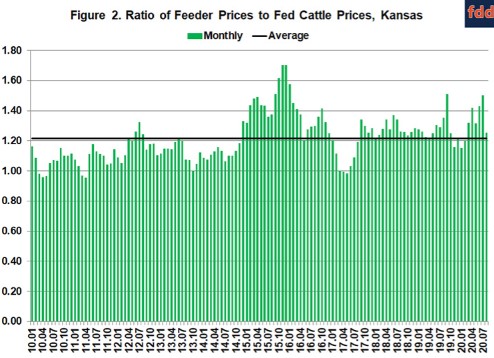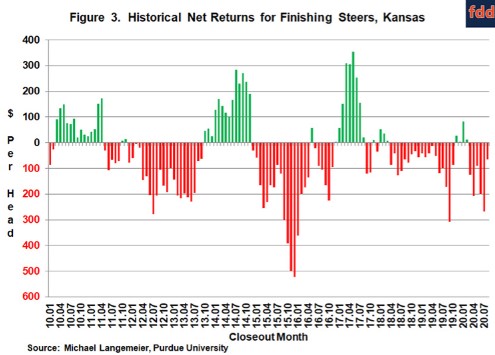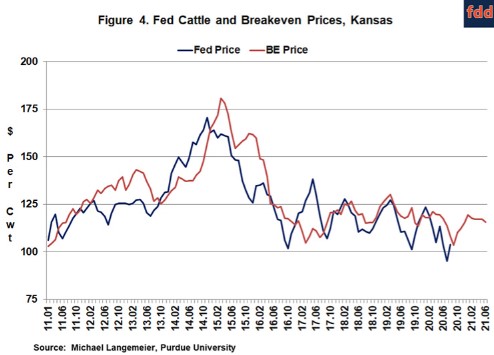By Michael Langemeier
Center for Commercial Agriculture
Purdue University
This year has exhibited wide swings in commodity prices, drastically changing net return prospects. Earlier papers examined net return prospects in early January (farmdoc daily January 10, 2020) and early May (farmdoc daily May 8, 2020). This article provides updated feeding cost of gain, breakeven prices, and net return estimates for the first nine months of 2020, and projections through the second quarter of 2021. It is important to note that the net return estimates in this article do not include Coronavirus Food Assistance Program (CFAP) payments. Information pertaining to these payments can be found in the fact sheets listed in the citations.
Several data sources were used to compute net returns. Average daily gain, feed conversion, days on feed, in weight, out weight, and feeding cost of gain were obtained from monthly issues of the Focus on Feedlots newsletter (here). Futures prices for corn and seasonal feed conversion rates were used to project feeding cost of gain for the next several months. Net returns were computed using feeding cost of gain from monthly issues of the Focus on Feedlots newsletter, fed cattle prices and feeder cattle prices reported by the Livestock Marketing Information Center (LMIC) (here), and interest rates from the Federal Reserve Bank of Kansas City.
Feeding Cost of Gain
Figure 1 illustrates monthly feeding cost of gain from January 2010 to August 2020. Feeding cost of gain averaged $84.37 per cwt. in 2019 ranging from a low of $81.61 in October to $91.67 in March. Feeding cost of gain per cwt. averaged $83.27 in the first quarter and $84.28 in the second quarter of 2020. Projected feeding cost of gain for the third and fourth quarters of 2020 are $78.75 and $80.75, respectively.

Feeding cost of gain is sensitive to changes in feed conversions, corn prices, and alfalfa prices. Regression analysis was used to examine the relationship between feeding cost of gain, and feed conversion, corn prices, and alfalfa prices. Results are as follows: each 0.10 increase in feed conversion increases feeding cost of gain by $1.24 per cwt., each $0.10 per bushel increase in corn prices increases feeding cost of gain by $0.88 per cwt., and each $5 per ton increase in alfalfa prices increases feeding cost of gain by $0.50 per cwt.
Feeder to Fed Cattle Price Ratio
The ratio of feeder to fed cattle prices since January 2010 is illustrated in Figure 2. Since January 2010, this ratio averaged 1.22. The feeder to fed price ratio was one standard deviation below (above) this average for 17 (19) months since January 2010. The average net return for the months in which the ratio was below one standard deviation of the average was $143 per head. In contrast, the average loss for the months in which the ratio was above one standard deviation was $257 per head. The average ratio for the 19 months with a feeder to fed price ratio that was above one standard deviation of the long-run average was 1.49. The feeder to fed cattle ratio averaged 1.22 in the first quarter and 1.39 in the second quarter of this year. In July, the feeder to fed cattle ratio was 1.50, resulting in large cattle finishing losses. The ratio declined to 1.25 in August and is projected to stay below 1.25 through the first six months of 2021.

Net Return Prospects
Monthly steer finishing net returns from January 2010 to August 2020 are presented in Figure 3. It is important to note that net returns were computed using closeout months rather than placement months. Net returns averaged a negative $80 per head in 2019. Net losses in the first quarter of this year averaged $10. Losses in the second quarter were $165 per head. Though large, this was approximately $90 per head lower than our estimates in early May. Due to low fed cattle prices and a high feeder to fed cattle price ratio, losses in July were $265 per head. Losses of $65 per head were experienced in August. Net returns for the rest of 2020 are expected to much closer to breakeven prices.

Historical and breakeven prices for the last ten years, as well as projected breakeven prices through the June of 2021, are illustrated in Figure 4. Breakeven prices for the first two quarters of this year averaged approximately $119 per cwt. Average breakeven prices for the third quarter and fourth quarter are expected to be approximately $108 and $113, respectively. For the first and second quarters of 2021, breakeven prices are expected to range from $116 to $119. Combining these breakeven prices with Livestock Marketing Information Center (LMIC) fed cattle price projections results in small expected losses in the first quarter (ranging from $25 to $50 per head) and expected net returns from $25 to $50 for the second quarter. Due to the amount uncertainty related to the current market environment, our typical caveats apply to these projections. Net return prospects could change rapidly.

Conclusions
This article discussed recent trends in feeding cost of gain, the feeder to fed price ratio, breakeven prices, and cattle finishing net returns. Average cattle finishing losses in 2019 were estimated to be approximately $80 per head. Average losses for 2020 are projected to be approximately $85 per head. Current breakeven and fed cattle price projections suggest that net returns will be closer to breakeven levels in the first six months of 2021, with the largest chance for positive net returns occurring in the second quarter.
Source : illinois.edu